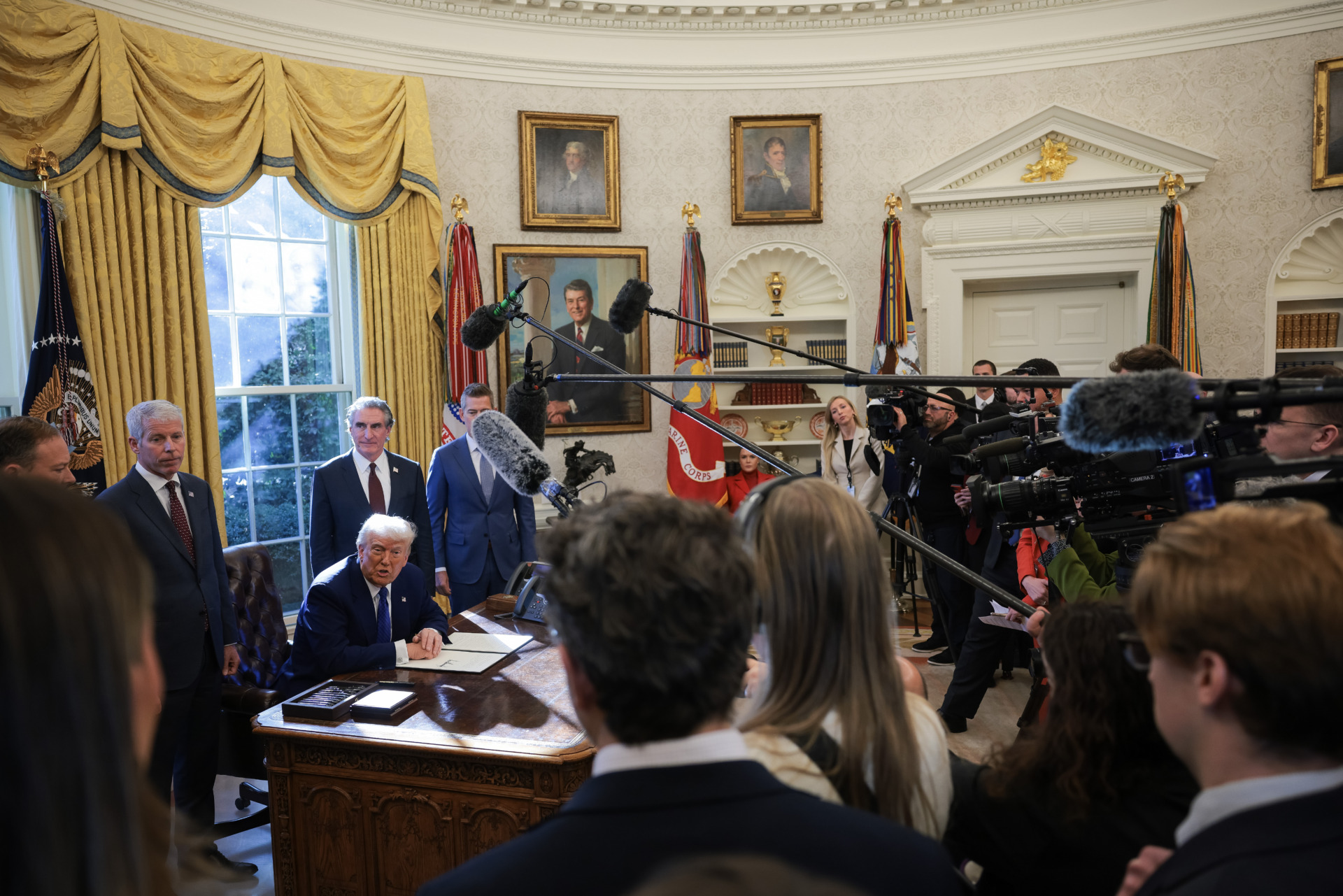
(Editor’s Note: This article, originally published May 2, 2025, is updated periodically to add recent developments in the interactive graphic, marked as “NEW,” and the latest analysis below.)
Faced with a barrage of breaking news out of the Trump administration, it is easy to become paralyzed. This is arguably intentional: Flood the zone to ensure the news cycle is so overwhelming that the media (not to mention, the public) cannot keep up. In this information ecosystem, it is crucial that people retain the ability to track how State power is being used. This, in turn, requires systematically identifying linkages between individual developments and broader trends.
The graphic below offers one method, or practice, of resistance to a “muzzle velocity” news cycle that makes it hard to think about, let alone understand, the ways in which the Trump administration is wielding State power. This focuses on threats to press freedom, but the concept can be applied to other broad issues, too. By absorbing each additional news item as a data point for or against a threat to a particular democratic norm, rather than as a singular development, it becomes possible to keep sight of the big picture – and direct action accordingly. (cont’d below…)
Credit: Threats to Press Freedom by Just Security
Click on any of the titles below to see more specific items and links through to reporting/sources.
This graphic is based on an earlier article I wrote for Just Security, which synthesized numerous breaking news items to illuminate a set of growing threats to press freedom. Those threats came from aggressive actions by the Trump administration, such as evicting independent media organizations from office space in the Pentagon in favor of enthusiastically pro-Trump outlets, and from appeasement actions by media outlets – like the ABC’s $15 million settlement with then-candidate Donald Trump in a case that legal experts say it could have readily won on the merits.
There is every reason to expect that freedom of the press will remain under threat for the foreseeable future, but the public will only be able to comprehend the scale and severity of the threat if individual developments are explained in reference to the bigger picture. And press freedom is far from the only pillar of a democratic society that is under attack. One could readily imagine running this same exercise to develop “Big Picture Trackers” that help keep track of threats to judicial independence, right to counsel, voting rights, and more.
Latest Analysis
October 3, 2025
After the previous press tracker update on Aug. 4, there was a relative lull in activity through the remainder of August. That changed in mid-September, with a flurry of attacks on press freedom in the aftermath of the assassination of conservative activist Charlie Kirk.
The most high-profile threat in this period came as Federal Communications Commission Chairman Brendan Carr reacted to comments made by late-night comedian Jimmy Kimmel in relation to Kirk’s assassination. Two major owners of ABC affiliates, Sinclair and Nexstar, said they would boycott the show, and then Carr, in an interview with far-right podcaster Benny Johnson, implied that the FCC would consider revoking Disney’s broadcast license (Disney is the parent company of ABC, which produces Kimmel’s show) if it did not pull Kimmel off the air. Here are excerpts from that interview:
“[T]here’s actions that we can take on licensed broadcasters. And frankly, I think that it’s sort of past time that a lot of these licensed broadcasters themselves push back on Comcast and Disney and say, “Listen, we are going to preempt. We are not going to run Kimmel anymore until you straighten this out because we the licensed broadcaster (cq) are running the possibility of fines or license revocations from the FCC if we continue to run content that ends up being a pattern of news distortion.”
Whether or not Carr intended this as a direct threat to Disney, that is evidently how the corporation understood it; just hours later, ABC announced that Kimmel’s show was suspended “indefinitely.” President Trump then posted on Truth Social “Congratulations to ABC for finally having the courage to do what had to be done.”
What followed was an immediate and intense pushback by consumers, who boycotted Disney’s streaming service; celebrities, who spoke out; and members of Congress, including Republican Senator Ted Cruz, who described Carr’s comments as “dangerous as hell.” A week later, ABC announced that Kimmel’s show would return to air, although Sinclair and Nexstar initially still refused to carry his program. Trump reacted with further threats on Truth Social:
“I can’t believe ABC Fake News gave Jimmy Kimmel his job back. The White House was told by ABC that his Show was cancelled! … I think we’re going to test ABC out on this. Let’s see how we do. Last time I went after them, they gave me $16 Million Dollars. This one sounds even more lucrative.” (Trump appears to be referring to the $15 million settlement he got from ABC when he was president-elect, after suing them for defamation in a claim that legal experts believed ABC could have won).
The Kimmel cancellation was not an outlier in the aftermath of Kirk’s assassination. The Washington Post fired Global Opinion columnist, Karen Attiah, for “public comments on social media regarding the death of Charlie Kirk” (read dismissal email here). Attiah, an award-winning journalist and 11-year veteran of the Post, was also the paper’s last remaining full-time Black columnist. Attiah is challenging the legality of her termination.
Beyond self-censorship and threats to harm outlets in relation to Kirk’s assassination, reporters and outlets disfavored by Trump continue to face hostile conditions more generally. Trump continues to display personal antagonism towards certain reporters, and on Sept. 15, he sued the New York Times for $15 billion in a defamation claim. The judge immediately struck down the filing for failing to meet the basic requirements of such suits, but Trump has leave to file an amended complaint. Another such lawsuit by Trump is also pending – the defamation claim he filed against the Wall Street Journal in August. On Sept. 22, the Journal filed for dismissal of that suit.
Finally, the administration renewed efforts to erode access for reporters who cover national security. Readers will recall (see the accompanying graphic) that Defense Secretary Pete Hegseth had already taken action earlier this year to erode access by ousting several media outlets from their longtime offices and desks in the Pentagon press area. Then in May, he posted a message on X severely restricting reporters’ movements within the Pentagon. In a memo released on Sept. 19, he announced that reporters covering the Pentagon would be required to sign a pledge not to gather any information, including unclassified material, unless “approved for public release by an appropriate authorizing official before it is released…” The National Press Club and other associations of journalists have condemned the memo as a dangerous incursion on the free press, and the Reporters Committee for Freedom of the Press is challenging the move. The memo also formalizes the movement restrictions, which had gone into effect, with “updated physical control measures for press/media access within the Pentagon.”
Analysis from Previous Updates
August 4, 2025
Since the previous tracker update on June 30, press freedom in the United States has continued to deteriorate. Developments in relation to two threats are of particular note.
First, there were unprecedented actions in relation to the threat classified in this graphic as “Harm to Outlets,” which tracks instances of State power being used to harass or shutter media outlets. On July 24, Trump signed a bill that Congress passed at his behest to rescind funding it had previously appropriated for the Corporation for Public Broadcasting (CPB). Then, on July 31, the Senate Appropriations Committee voted not to provide CPB funding going forward. This marks the first time that Congress, which established the CPB in 1967 as a private nonprofit, will not appropriate funds for the Corporation. The CPB’s role has been to distribute federal funds to support more than 1,500 locally managed and operated public television and radio stations nationwide, as well as their research, technology, and program development. On Aug. 1, the CPB announced that it would be closing.
Second, in relation to the threat category “Currying Favor” which tracks deal-making between the president and media/platform owners, the Trump administration approved the Paramount-Skydance merger. The approval came after Paramount agreed to a $16 million settlement deal with Trump over his lawsuit against Paramount over the CBS show 60 Minutes’ pre-election interview with Kamala Harris. (This joins the list of multi-million dollar settlements by major outlets with Trump in relation to suits that legal experts say could have been won by the outlets in court.) The merger approval also came on the heels of an announcement by CBS that it was canceling “The Late Show with Stephen Colbert.” Colbert has been a fierce critic of both Trump and the Paramount-Skydance merger.
Among the dynamics to watch in the month ahead is the escalating fight between Trump and the Wall Street Journal, after the paper reported on a lewd birthday card sent by Trump to the now-deceased child sex offender, Jeffrey Epstein. Invoking tactics that are becoming familiar, Trump excluded a Wall Street Journal reporter from one of his press pools in Scotland, and filed a $10 billion lawsuit against the Journal for defamation.



